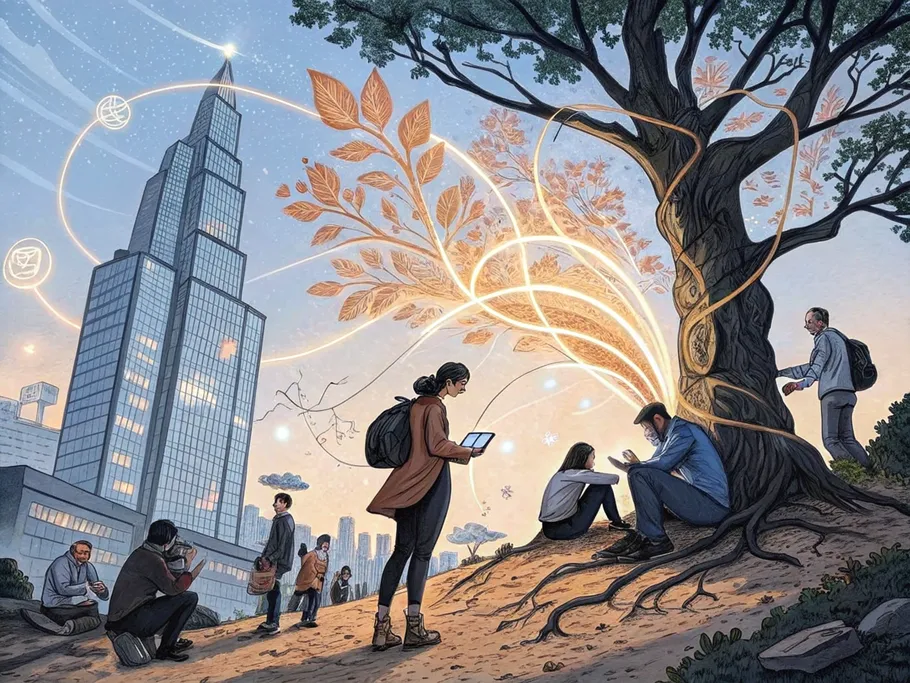The Internet is changing insanely fast. In a sense, your strategy MUST change.
But also, you have to double down on certain things that will never ‘go out of style’.
If you’re used to optimizing your content for Google, using SEO plugins, hiring keyword researchers, and hoping to land on page one…
That entire playbook is quietly becoming obsolete. We’re witnessing a marketing evolution…
… and a lot of people are misinterpreting it.
If you chase the AI trend too much, you risk screwing everything up. At the same time, if you don’t innovate, you can’t progress like everyone else.
In the next 1–3 years, we’ll see one of the biggest shifts in how people use the internet since the birth of search engines.

I’ve talked about it a lot already, but let me recap.
Up until recently, about 90% of internet users entered the web through Google. They would type in a question, click a result, and (maybe) find what they need.
But in 2025, that behavior is starting to shift.
People are ‘googling’ through AI tools like ChatGPT, which provides faster, more direct answers than any blog post or landing page can.
(And btw…with no popups, cookies. or 12-paragraph how-to guides with affiliate links.)
We’re a bit lazy as a species, so it’s no surprise that we all DEVOUR this mode of finding information.
As with any huge shift, people find ways of adapting. You should as well.
However, a lot of people have already forgotten the more ‘human’ elements for the sake of automation – and it sucks.
I see so many diluted brands that undervalue emotional connection, style, content strategy, etc. So let me tell you what (in my humble opinion) will and won’t change.
Pretty much – SEO as we know it:
Read this carefully, ‘cause you’ll find your competitive advantage here. While most people will scale their operations by speeding up absolutely everything using AI… you won’t forget the human elements, and your brand won’t stink:
That’s the paradox of the next 3 years:
Marketing will become more technical… and more human at the same time.
The fact that my ebook is AMAZING will also never change. It’s called ‘Startup Launch Roadmap’, and you can get it right here:
Let’s talk money.
Right now, Google Ads works because people search, see sponsored results, and click them.
In an AI-first world, users aren’t clicking anymore.
Which means that new, exciting advertising opportunities will emerge:
This might sound futuristic (I mean, it is a marketing evolution article, after all) – but it’s already starting to happen. People are reporting traffic drops ALL over the world. (scaaaaaaary, or is it…?)
You won’t just be running ads on search engines.
You’ll be embedding offers directly into the flow of AI-powered conversations.
The question becomes:
“How do I promote my product in a world where people don’t search the old way anymore?”
Probably social media, as well as LLM optimization. That’s what I’d focus on if I were you (and if I were me!)

Here’s another one that will literally never change.
And yet… lots of founders forget it.
Marketing is not a task you do after building your product.
It’s a lens you use while building it.
The question is no longer just “what should I build?” but rather, “what will people instantly understand and want to share?”
Apple did this all the time. All their departments were extremely interconnected, so that they could work together to make the sexiest products in the world.
To do that, you need:

Okay, let’s talk about sustainability.
WAIT!
I see the cursor switching to another site. You don’t want to do that, because I’ll give you some sauce (as always).
Founders building sustainable or ethical products often lead with features. Recyclable, renewable. plastic-free.
Booooooring!
You already know consumers DON’T buy features. They buy identity. They buy the story they get to tell themselves.
I’m not saying that people who care about the environment do so performatively.
I am saying we ALL buy things based on identity, and eco-conscious shoppers do that too (who would’ve thought…)
They don’t want to save the planet in theory. They want to feel proud in practice.
So if you’re doing something related to sustainability (and it’s always good to include that a little), your marketing must:
In a world where AI answers get blunter and blander, emotional resonance becomes your biggest differentiator.
Let’s zoom out for a second and take a deep breath.
Even if the interfaces change…
Even if SEO fades…
Even if AI eats search…
The human side of marketing still matters.
What matters is:
None of that is going away.
In fact, it’s about to become more important.
Because if everything online becomes increasingly robotic and generic, people will crave realness more than ever.
Creators, coaches, and founders who show their face and tell the truth – they’re going to win.
The people who integrate AI, but don’t become literal robots. Hell no.
You just read a piece on The Marketing Evolution (dun dun dunnnn).
The internet is going through its biggest interface change since the creation of search engines.
Here are the main points to keep in your back pocket:

Email subscription is available ONLY TODAY (oh, okay, and tomorrow).
Surely, we respect your inbox! Unsubscription works every day.

We’d love to tailor your experience — which of these best describes you?